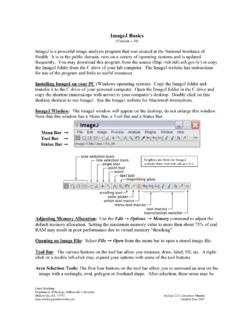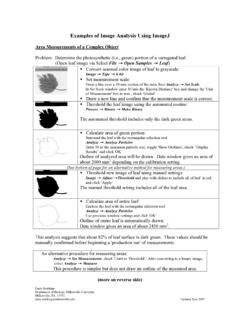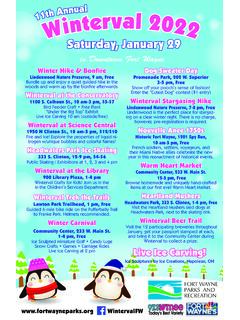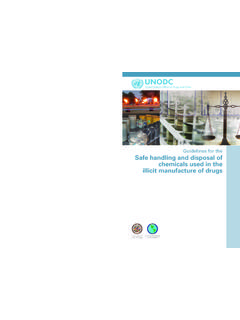Transcription of Photonic Solutions for Biotechnology and Medicine Image ...
1 Search areas, from nanotechnology to as-tronomy. It is common practice for manufactur-ers of Image acquisition devices to includededicated Image processing software, butthese programs are usually not very flex-ible and/or do not allow more compleximage manipulations. Image processingprograms also are available by themselves. ImageJ holds a unique position becauseThe advances of the medical and bi-ological sciences over recent years,and the growing importance of de-termining the relationships between struc-ture and function, have made imaging anincreasingly important discipline. Theubiquitousness of digital technology from banal digital cameras to highly spe-cific micro-CT scanners has made im-ages an essential part of a number of re-As the popularity of the ImageJ open-source, Java-based imaging program grows, its capabilities increase,too.
2 It is now being used for imaging applications ranging from skin analysis to neuroscience. by Dr. Michael D. Abr moff, University of Iowa Hospitals and Clinics; Dr. Paulo J. Magalh es,University of Padua; and Dr. Sunanda J. Ram, Louisiana State University Health Sciences CenterImage Processing with ImageJit not only is in the public domain (mean-ing that its source code is openly avail-able and its use is license-free), but alsoruns on any operating system. It is at-tractive because it is easy to use, can per-form a full set of imaging manipulationsand has a huge and knowledgeable usercommunity. The program is the brainchild of WayneRasband of the Research Services Branch,National Institute of Mental Health, inBethesda, Md.
3 It is called ImageJ becauseit is written in the Java language. Its firstrelease, version , was Sept. 23, 1997,and it is now in version , released inFebruary. According to the institute, it has beendownloaded from its Web site tens ofIMAGINGSOFTWAREF igure 1. A scintillation rendering ofthe 3-D motion field of a fat-musclephantom was combined with asurface rendering to show motionand anatomy of the phantom. Themotion data were obtained as MRI gradient echo T1weighted Image sequences, whilethe phantom was rotated in place at5 per frame. The motion field is toodense for motion and surface to berendered in the same place. The axis of rotation was orientedperpendicular to the surface of thephantom. The hue of the color codesfor direction, and the saturation ofthe color codes for motionmagnitude.
4 Obtained with ImageJrunning VolumeJ for volumerendering and FlowJ for 3-D opticalflow estimation. Provided byMichael Abr from the July 2004 issue of Biophotonics International Laurin Publishing Co. Laurin PublicationPhotonic Solutions for Biotechnology and MedicineObviously, with a freeprogram, there is no tele-phone hot line for , a large user basecommunicates through amailing list. This way, anyuser is free to ask ques-tions, put forward sugges-tions or ideas for newimaging functions andpublish Solutions . At thetime of this writing, thiscommunity consisted ofmore than 1000 users/scientists (the majority)and users/developers (insmaller numbers, but offundamental importance).Indeed, the know-howof the community is re-markably high becausemany members possess adetailed knowledge of thesoftware and the imagingproblems that the programcan address efficiently.
5 Arequest on the mailing listis usually all it takes forsomeone, somewhere inthe world, to provide the required example, Dr. Rex Couture of thedepartment of radiology at WashingtonUniversity School of Medicine in St. Louisran into a problem with reading largemicro-CT images. These files were about5 GB, but ImageJ couldn t read beyondthe 4-GB limit at that time. I posted aquery about this, Couture said. Withinan hour or two, someone workingthrough the night in Europe had foundthe problem. By 9:30 the next morning,I had a solution to try from wayne . Sincehe didn t have an Image file that large, hecouldn t test it, and it didn t quite hours later he had created atest Image , and I had a fully debuggednew version that solved the problem.
6 Shortly thereafter, someone in the dis-cussion group also posted a way to openlarge tiff has always been a somewhat terseusage instruction on the ImageJ Web site,but getting advice on a specific functionrequired taking the quite intimidatingstep of asking the mailing list. Now onehas the option of using a manual recentlyproduced by Tony Collins at the Wrightthousands of times, withthe current rate being about24,000 downloads permonth. Rasband said that,after working for 10 yearson NIH Image , ImageJ sprecursor, he didn t see a bright future for it, eventhough Scion Corp. ofFrederick, Md., had portedit from a Macintosh-onlyversion to the PC/Windowsplatform. However, theScion version wasn t opensource, and he is a strongproponent of open sourceand platform indepen-dence.
7 So he began writingImageJ in early 1997 afterhe had become intriguedby the new Java program-ming language. Imaging capabilitiesImageJ can read mostof the common and im-portant formats used inthe field of biomedicalimaging (see table). If afile format is not currently supported,someone from the international user/developer community usually developssupport within days. In addition,ImageJ can be used to acquire imagesdirectly from scanners, cameras andother video sources, including camerasthat are compatible with TWAIN andFireWire, and frame grabber boardsfrom Cooke, National Instruments program supports all commonimage manipulations, including readingand writing of Image files, and operationson individual pixels, Image regions, wholeimages and volumes.
8 Volumes, calledstacks in ImageJ, are ordered sequencesof images that can be operated upon as awhole. It can perform basic operationssuch as convolution, edge detection,Fourier transform, histogram and parti-cle analyses (including sophisticated sta-tistical processing of groups of particles),editing and color manipulation; and moresophisticated operations such as dilation,erosion and closing of structures, andmathematical operations on sets of im-ages, such as multiplication, exclusive or,and division. In addition, visualizationoperations, including color space con-versions for example, converting fromRGB to Hue Saturation Intensity colorspace, two- and three-dimensional plot-ting and surface and volume render-ing, are supported.
9 It also offers core sup-port for analyzing electrophoretic of the strong points of ImageJ is its ability to run on different covering the last three months,with more than 80,000 downloads, in-dicate that it is being used mostly withMicrosoft operating systems (80 percent),followed by Macintosh platforms (16 per-cent) and Linux (4 percent). Althoughthese numbers are estimates and can bemisleading because someone could down-load it to one platform and use it on an-other, it is interesting to note the rela-tively high number of Macintosh users(the worldwide market share was less than2 percent in 2003, according to marketresearch company IDC), supporting thelong-held view that this type of computerattracts large sections of 2.
10 This screen shot shows thresholding, edge detection,particle analysis with particles indicated, and histogram analysis onthe gray-scale diatoms Image (upper left). Cell Imaging Facility at Toronto WesternResearch Institute. This free, very thor-ough manual has many examples and il-lustrations. It emphasizes microscopy andaccompanies a collection of microscopy-related plug-ins. Although many open-source programs lack an extensive usermanual, even novices can find most ofthe information for their imaging needsin this : Macros and plug-insThe program is virtually limitless be-cause of the availability of user-writtenmacros and plug-ins. Macros are meant to make it easier toautomate oft-repeated tasks, which wouldbe tedious to implement has an easy-to-use macro-languagethat means that knowledge of Java isn trequired for writing simple scripts.










